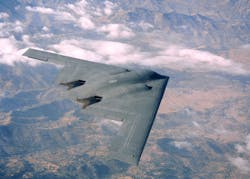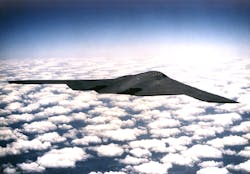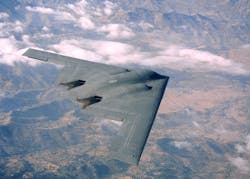Northrop Grumman producing EHF SatCom system for B-2 Spirit multi-role stealth bomber under $108 million U.S. Air Force contract
PALMDALE, Calif., 15 Oct. 2012.Northrop Grumman Corp. (NYSE:NOC) won a $108 million, low-rate initial production contract to deliver new, high-speed processing subsystems for the U.S. Air Force's B-2 stealth bomber fleet.
"The EHF Increment 1 upgrades provide a smart, cost-effective way to enable future combat capability on the B-2," says Ron Naylor, director of B-2 modernization and transformation for Northrop Grumman. "Every current and future upgrade program for the jet will benefit from the quantum leap in processing power and data handling capacity provided by this new hardware and software."
Northrop Grumman-provided hardware and software, including an integrated processing unit, a high-capacity drive, and a network of fiber-optic cable, will enable the aircraft to perform advanced communications and weapons delivery missions. The company’s engineers are producing the new subsystems as part of Increment 1 of the Air Force's B-2 extremely high frequency (EHF) satellite communications program.
Northrop Grumman is prime contractor for the Air Force's B-2 Spirit, which is a long-range strike arsenal, one of the world's most survivable aircraft systems, and considered the only combat-proven stealth platform in U.S. inventory.
The Air Force conducted a series of operational tests of the EHF Increment 1 hardware and software in late July.
Northrop Grumman is beginning to install the new subsystems in a limited number of aircraft as part of the current EHF Increment 1 system development and demonstration contract.
Each new EHF Increment 1 hardware kit includes: an integrated processing unit developed by Lockheed Martin Systems Integration in Owego, N.Y., that will replace up to 12 current, stand-alone avionics computers on the B-2; a disk drive unit developed by Honeywell Defense and Space Electronic Systems in Plymouth, Minn., that will enable transfer of EHF data onto and off of the B-2; a network of fiber-optic cable that will support the high-speed data transfers within the aircraft.
The B-2 long-range, large-payload U.S. aircraft can penetrate deeply into access-denied airspace. It can fly more than 6,000 nautical miles unrefueled and more than 10,000 nautical miles with just one aerial refueling, giving it the ability to reach any point on the globe within hours.
Follow Avionics Intelligence news updates on Twitter (@Avionics_Intel), LinkedIn, and Google+.


